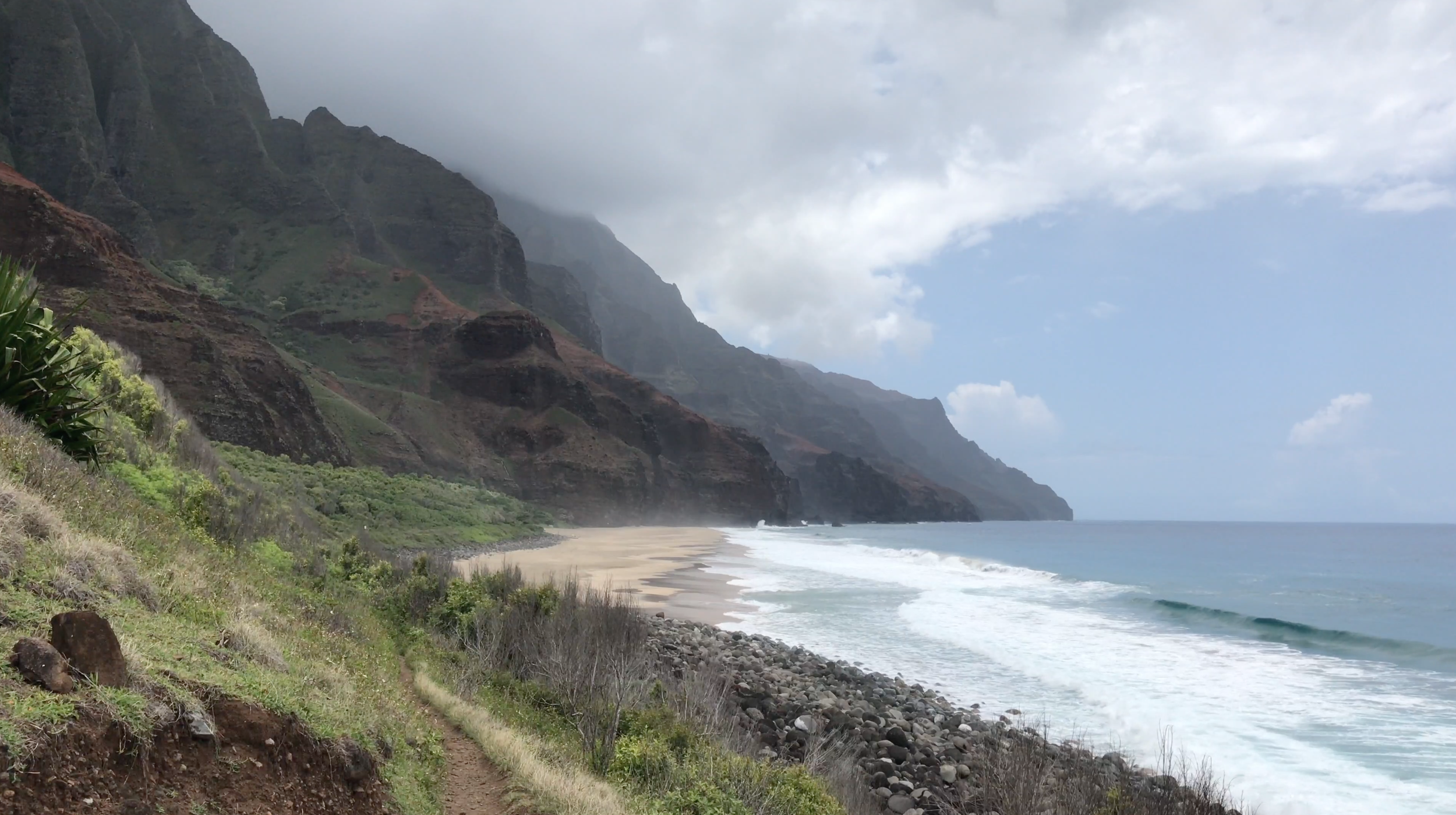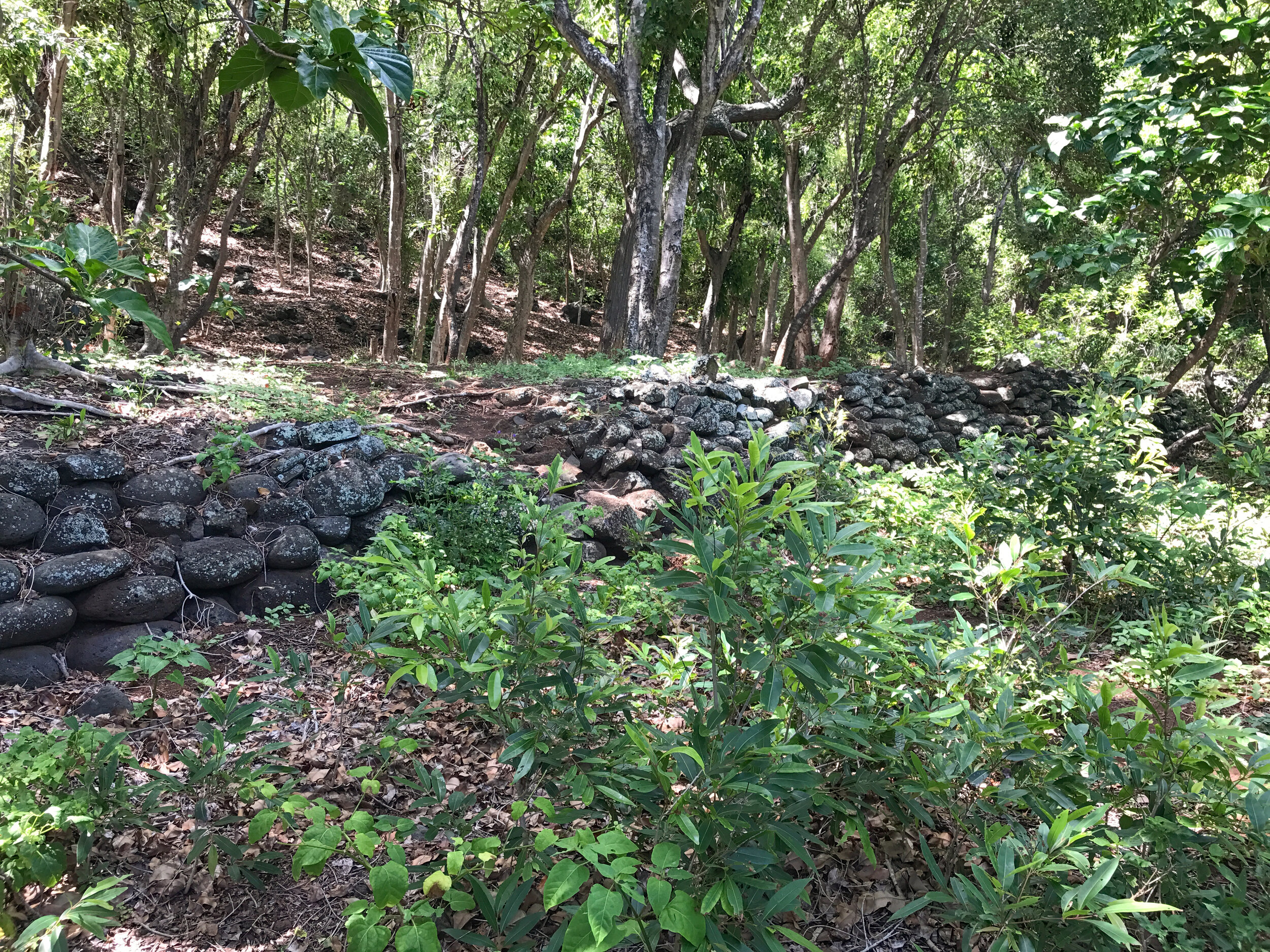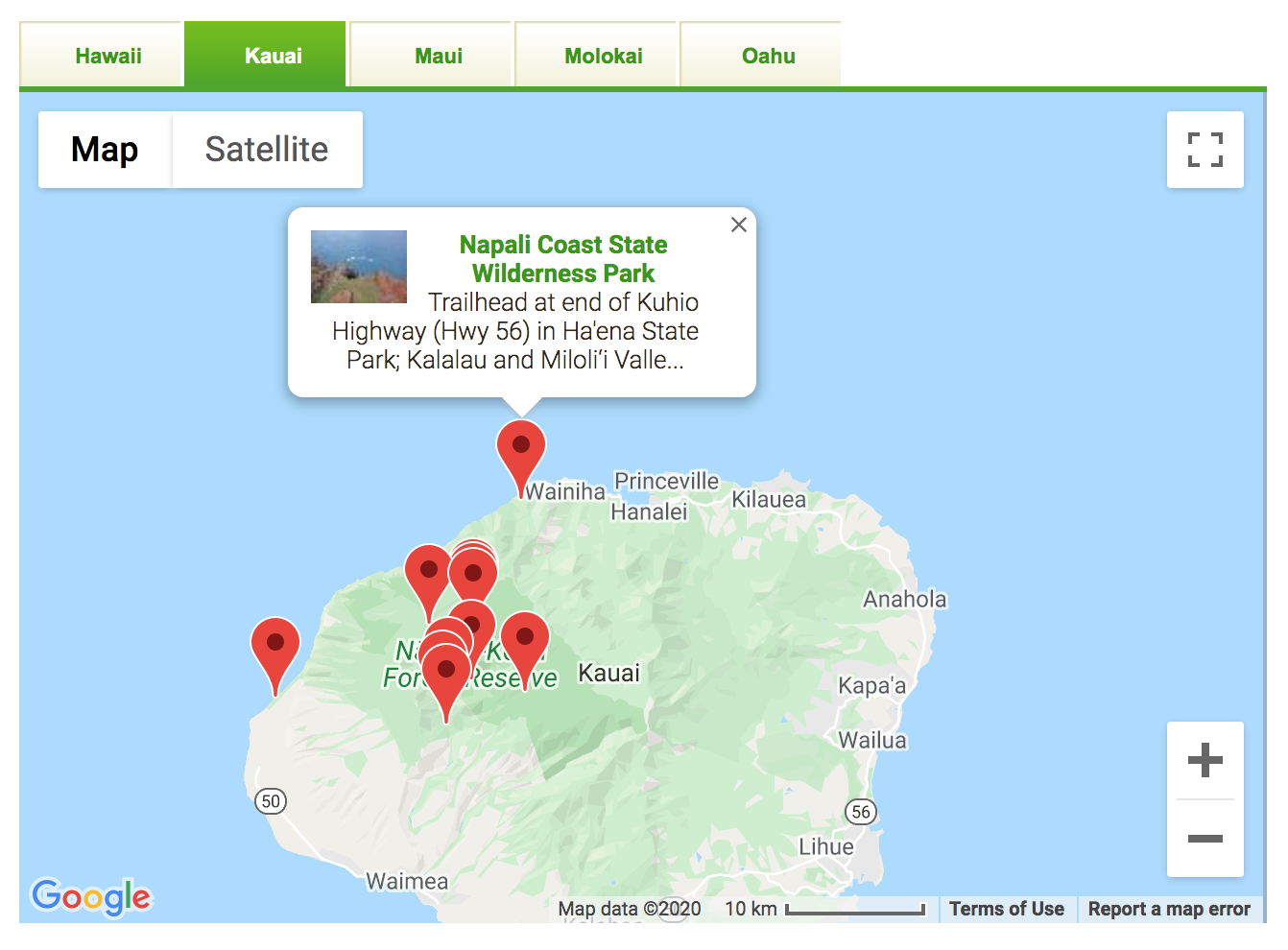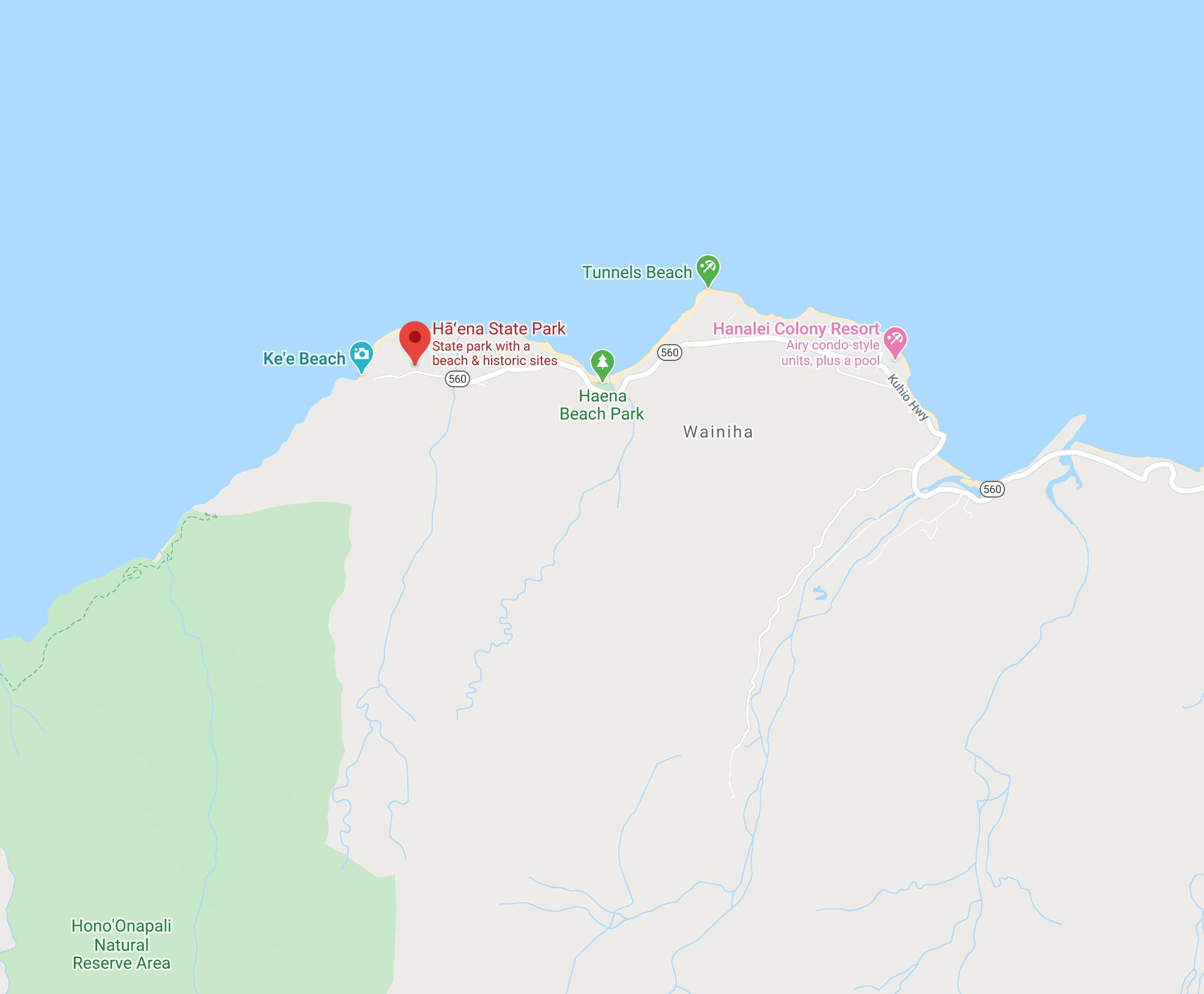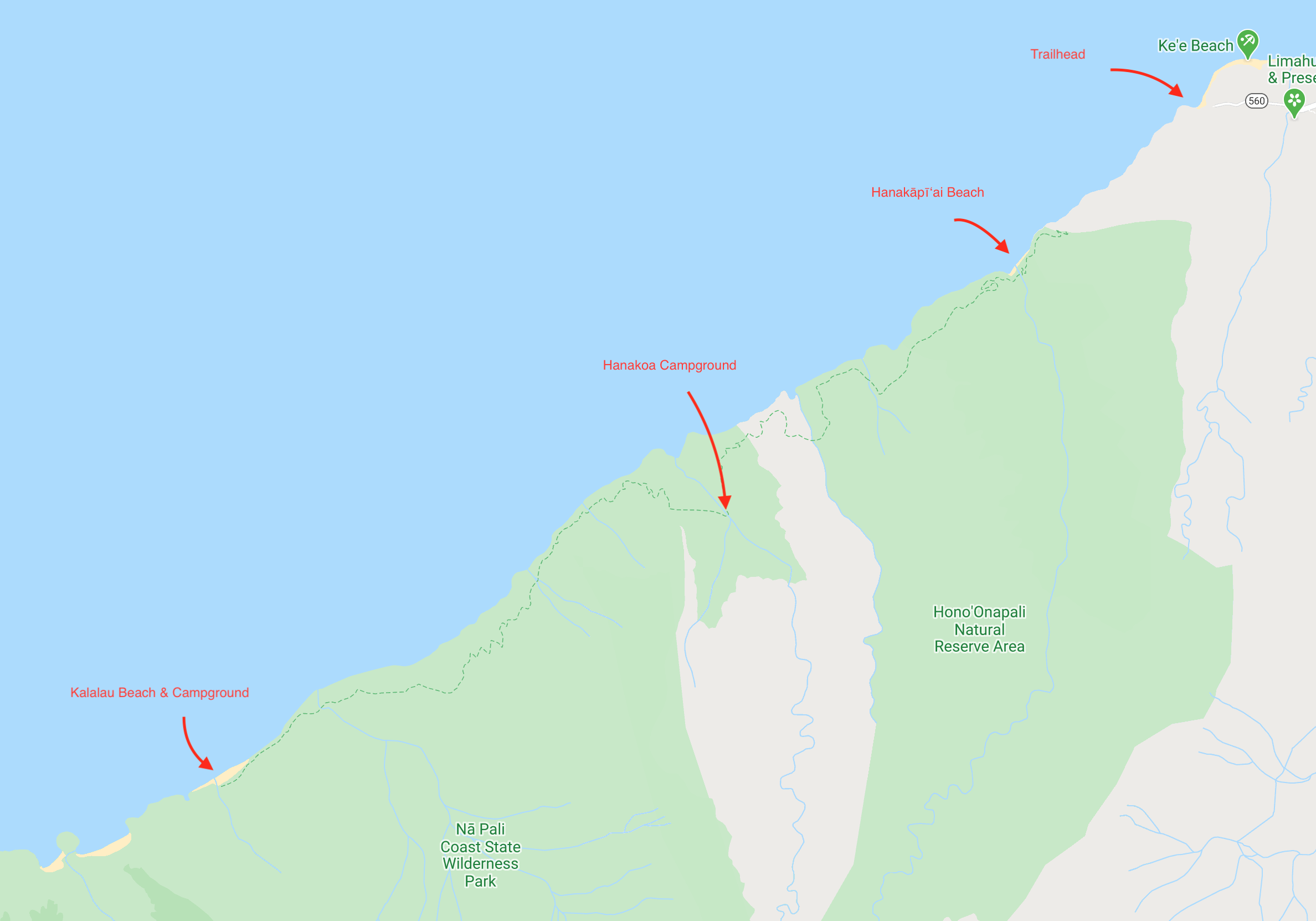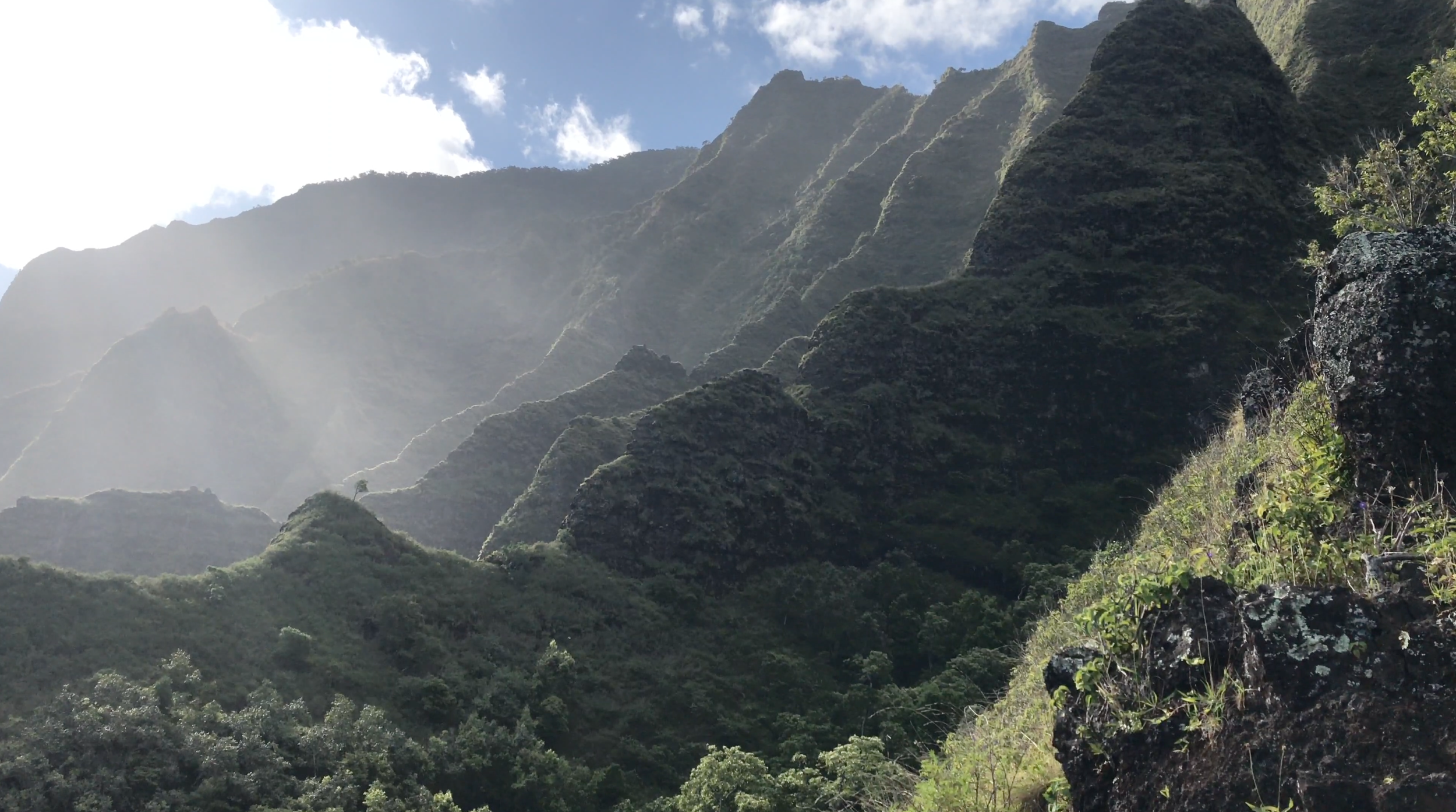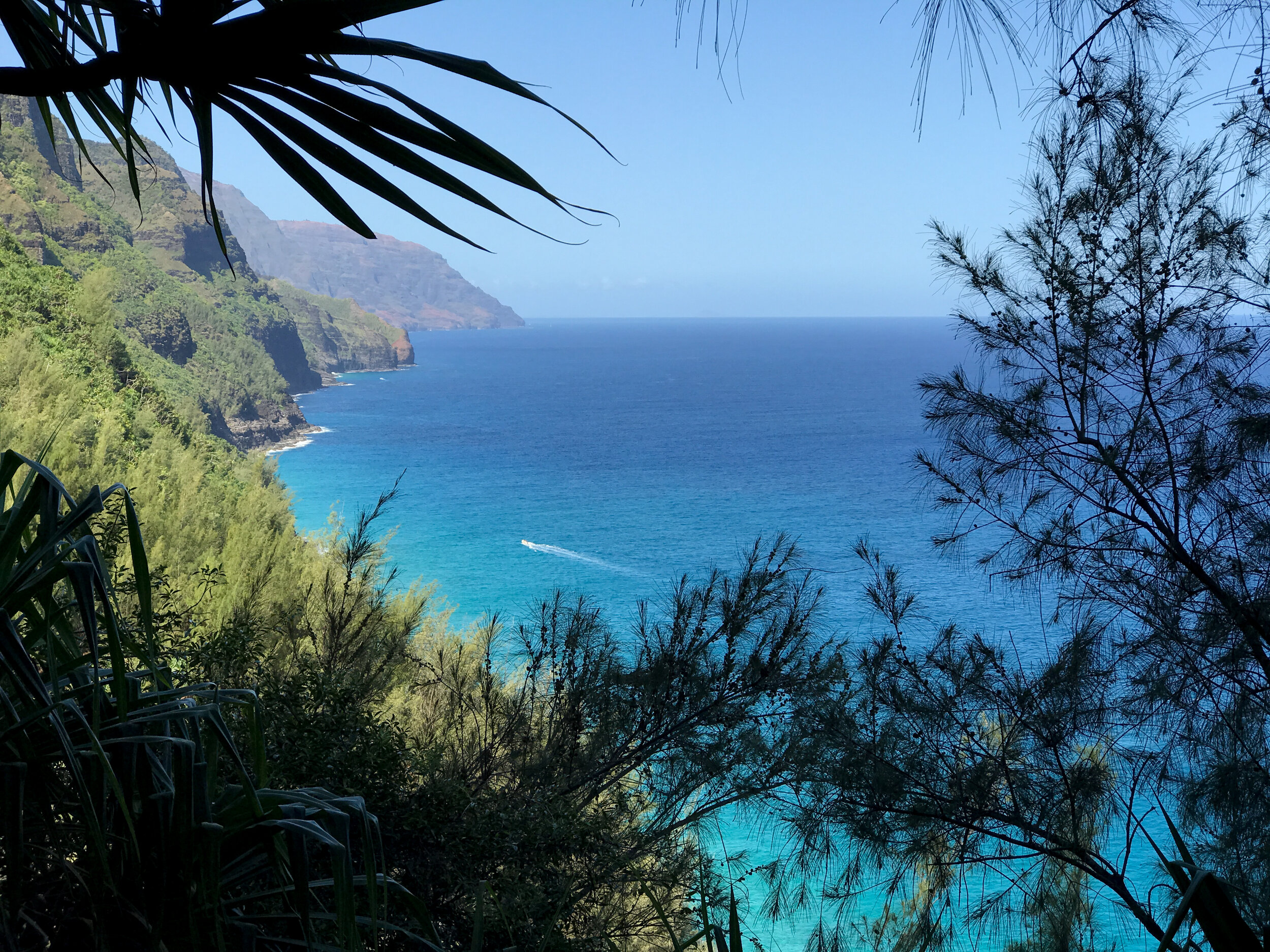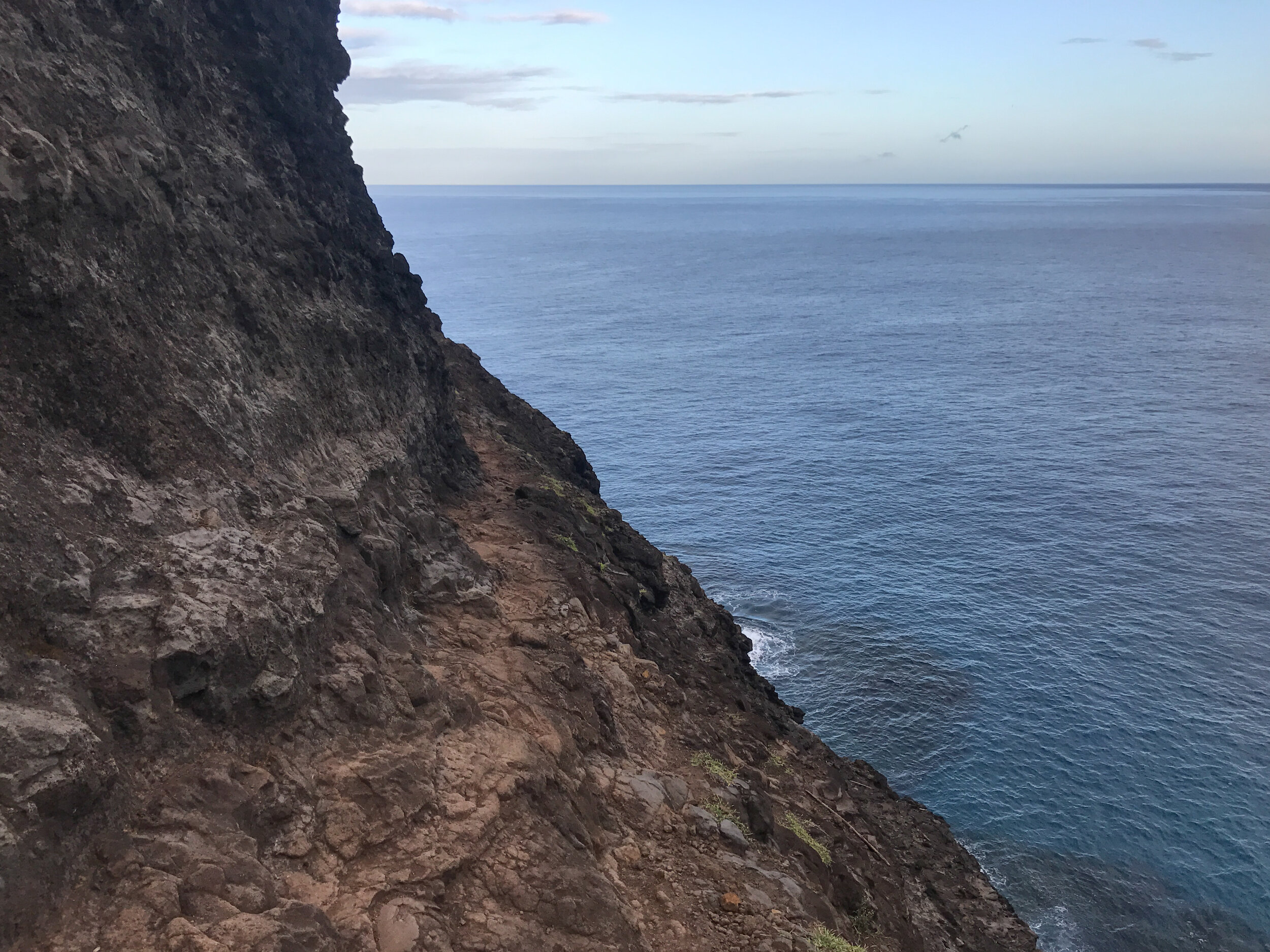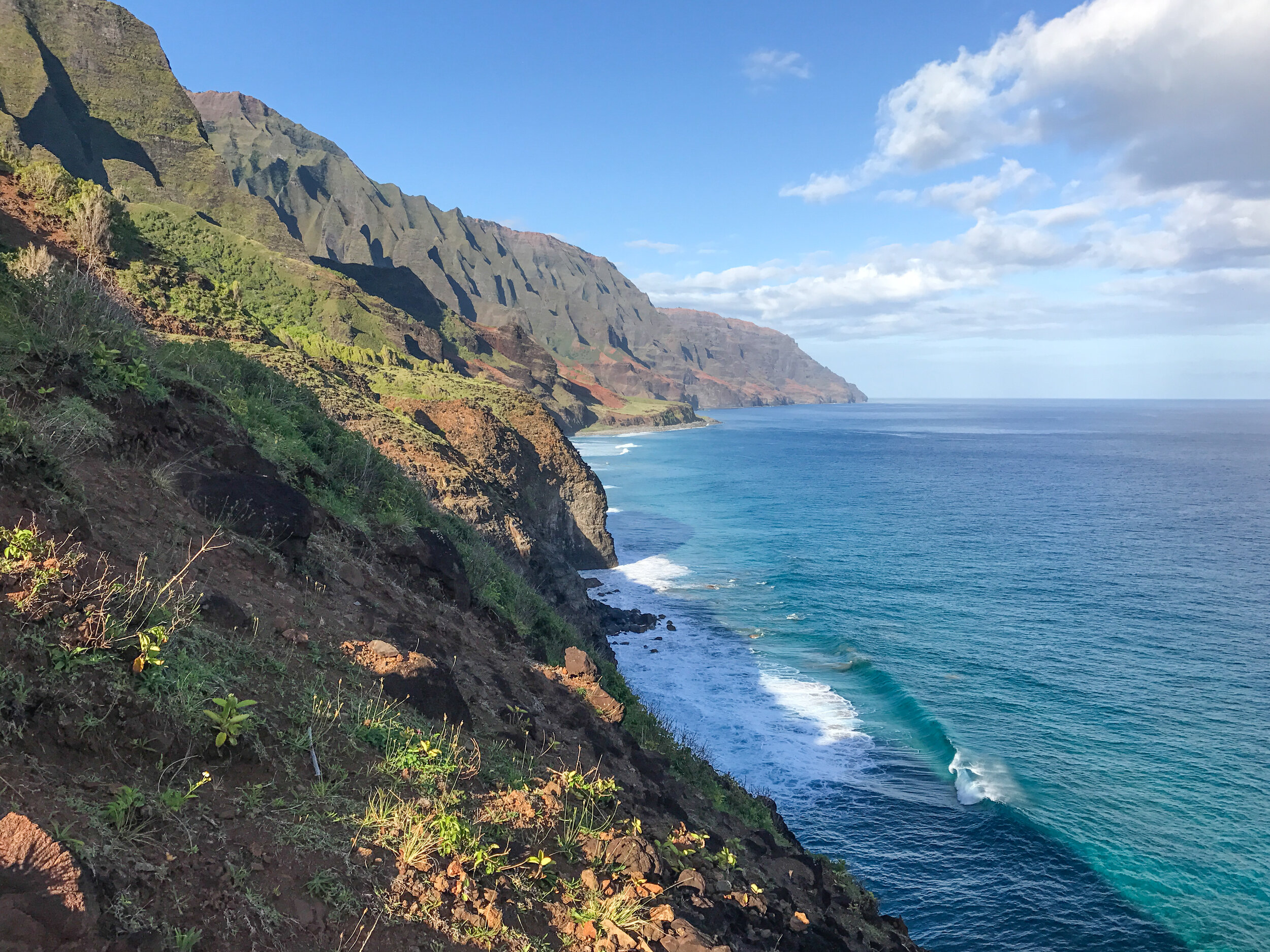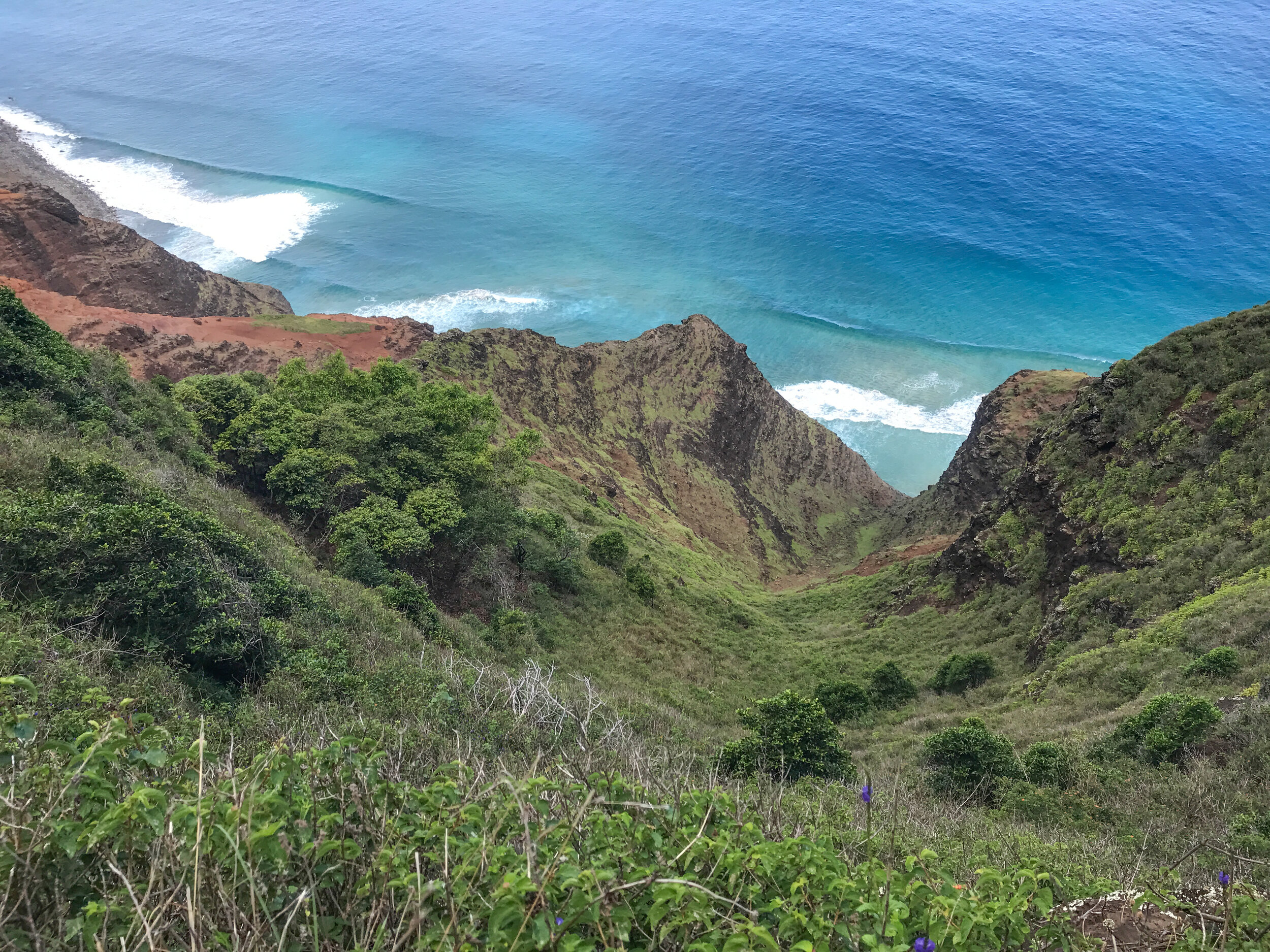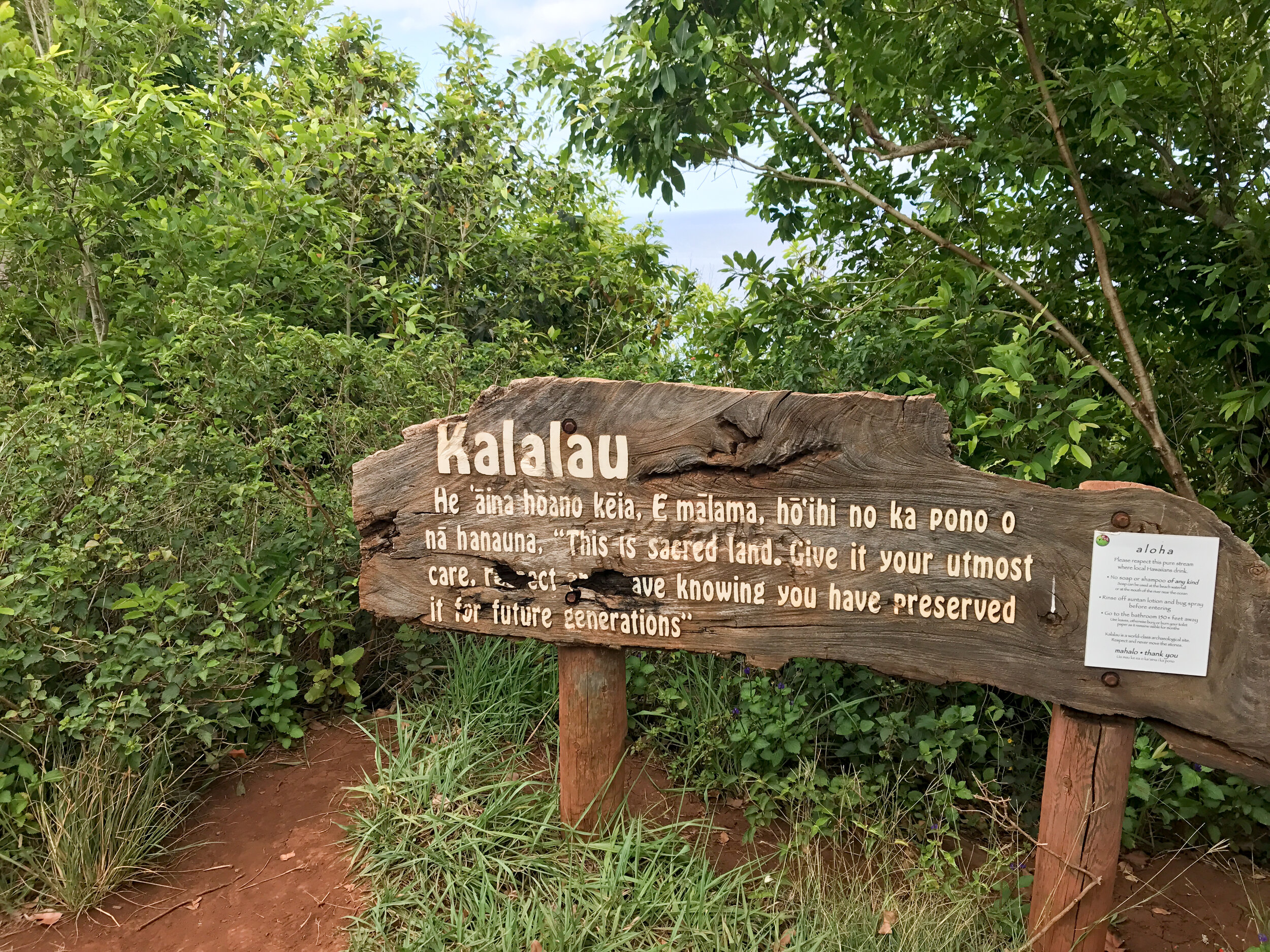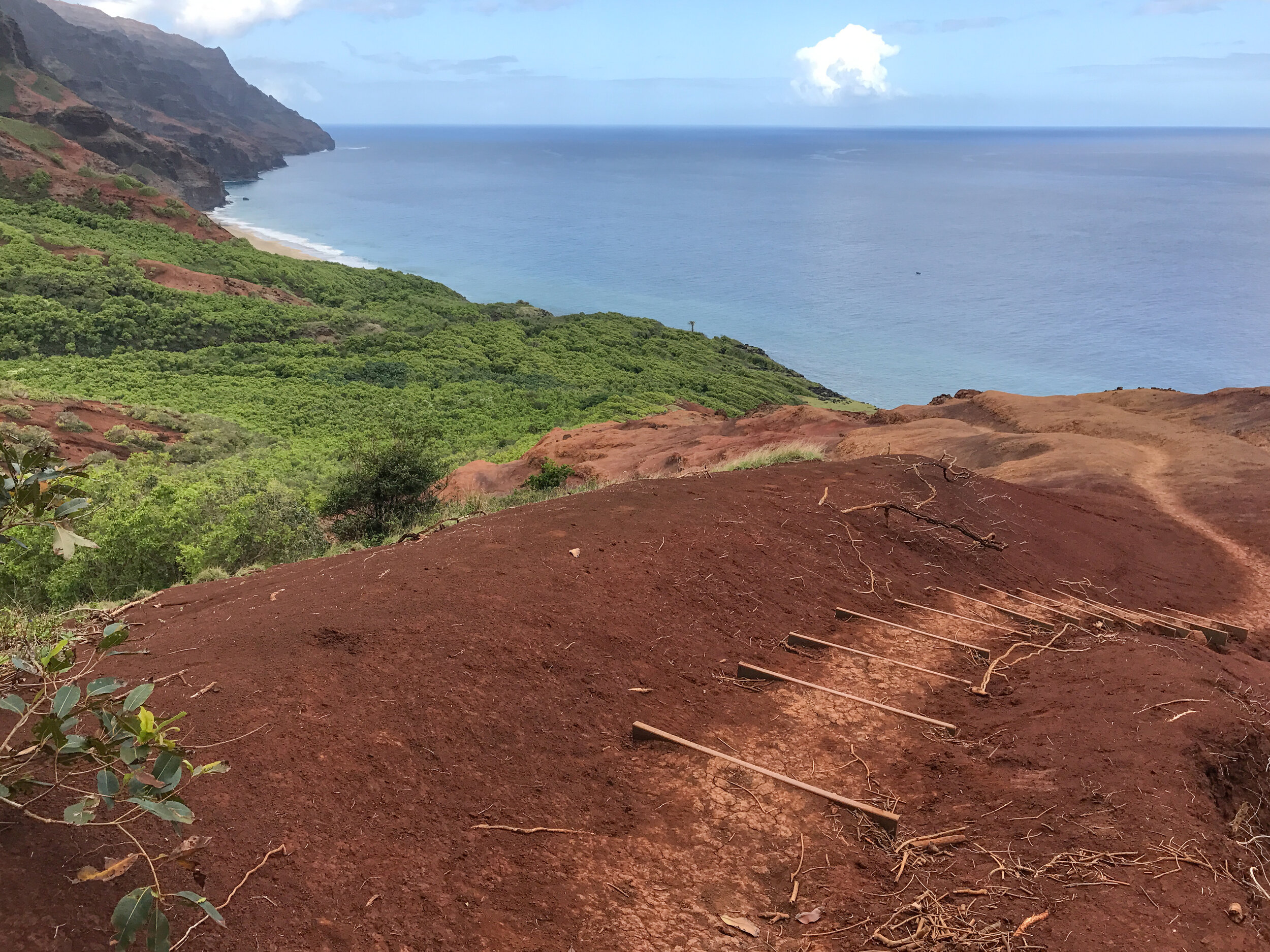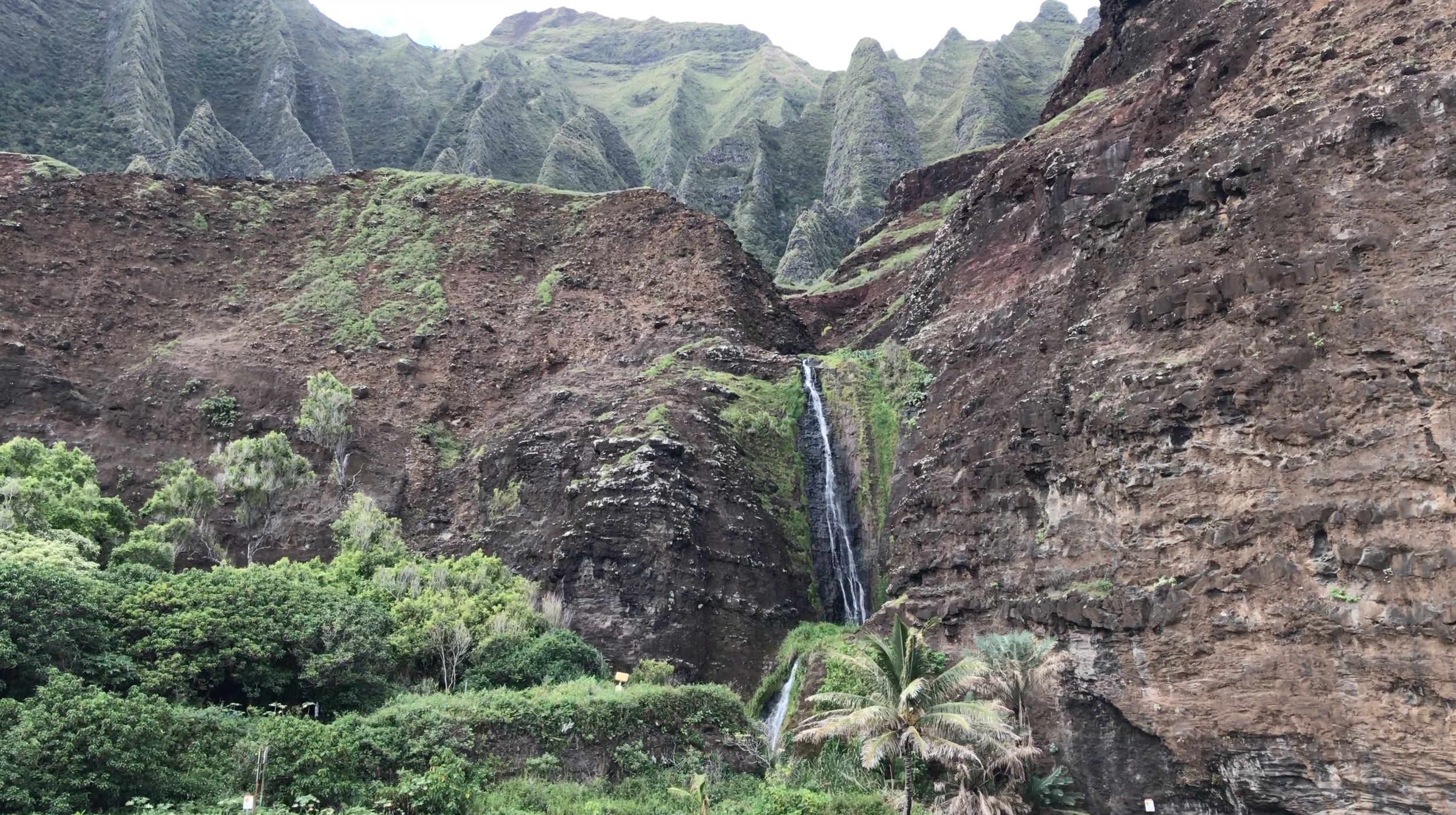Kalalau Trail
Last Updated: Feb 18th, 2020
About
The Kalalau Trail is an 11-mile (one way) backpacking trail located in Nāpali Coast State Wilderness Park, Kauai. The trail was originally constructed in the 1800’s, though construction technically continues to this day due to occasional mudslides and washouts. At that time, there were still settlements along the coastline, and the original trail linked these settlements together.
Many sections of the trail are very narrow and steep. Erosion happens relatively easily here, so rains can occasionally cause sections of the trail to fall away.
At the end of the trail lies the Kalalau Valley and Kalalau Beach. The valley is surrounded by 2,000 ft. fluted cliffs, and was once inhabited by native Hawaiians even into the 20th century. At one point, its inhabitants numbered in the thousands. Some of their agriculture — like mango, guava, and cherry tomato — is still prevalent today.
Many of the walls making up their terraced gardens still exist. Please respect Kalalau by packing out your trash and never manipulating the stones that make up the walls. This place holds a deep history and culture for the Hawaiian people.
Top tips
Permits for the Kalalau Trail are highly sought after. You will want to acquire permits far before the time you’d like to visit the island. I visited in May of 2017 and acquired my permits in December of 2016. Currently, permits become available 90 days in advance at 12:00am HST. Be ready to register right when they go live. Registration requires a free account, so get one before hand.
You may still choose to bring your rainfly for privacy, but I highly recommend bringing a tarp like the Gold Armour Waterproof Tarp. Tropical camping can be very humid and discomforting. Allowing your tent to air out at night — while leveraging the tarp to protect you from rain — is a huge advantage.
Bring a small, personal roll of toilet paper. The compositing toilets at the campgrounds are not well stocked.
Bring a thin sheet instead of a sleeping bag. Average nighttime temperatures are in the upper-60s almost year round. You will not use your sleeping bag.
I’ve hiked up to 20 miles in a day in the mountains, but a short distance in the Kauai sun was brutal. When possible, I would start your hiking very early, perhaps even before dawn.
Plan your transportation ahead of time. Many cab companies on the island will not drive you all the way to the northern coast. If you do not have your own transportation, call various cab companies ahead of time, find one that will give you a lift, and make plans for when you need to be transported.
There is no cell service in Hāʻena State Park — the location of the Kalalau Trail trailhead.
Permits
Kalalau Trail
Venturing beyond Hanakāpīʻai Beach — end of mile 2 — requires a backcountry permit. Kalalau Permits are acquired by visiting the Hawaii Department of Land and Natural Resource Online Reservation System.
During the process you will select the Kauai tab and the Napali Coast State Wilderness Park pin.
Currently, permits are available 90 days in advance at 12:00am HST. You should immediately attempt to reserve permits the moment they are made available for your timeframe.
Making a reservation requires a free account. Set your account up beforehand so you’re ready to register right away.
The maximum stay is 5 nights.
Hāʻena State Park
The trailhead for the Kalalau Trail lies adjacent to Ke`e Beach in Hāʻena State Park.
In April of 2018, the island received an immense amount of flooding due to thunderstorms. In a 24-hour period of time, a rain gauge just west of Hanalei recorded 49.69” of rainfall. This dwarfed the previous 24-hour record of approximately 38”. The flood was the worst natural disaster on the island since Hurricane Iniki in 1992.
Miraculously, no deaths were reported. However, sections of the Kalalau Trail and Highway-560 were washed out.
Reconstruction took over a year, and during this time many improvements were made to better preserve Hāʻena State Park and serve residents of the area.
Hāʻena State Park now limits visitors and requires a day pass. Visitors with a valid Kalalau Permit are not required to acquire a Hāʻena State Park day pass. There is also limited parking available for visitors with a valid Kalalau Permit. However, you should always check the Hāʻena State Park Online Reservations website to make sure the rules have not changed.
When to go
Many people expect the weather in Hawaii to be perfect year round. The reality is, the Hawaiian islands receive a lot of rain. During the fall and winter, that rainfall increases — a lot. In general, as you skip islands from east-to-west, each island will receive more rainfall than the previous. Kauai is the western most inhabited island.
The months that receive the most rain are October, November, December, and January. February and March receive quite a bit as well. It may be tempting to visit during these months due to your weather at home. However, the rain can cause flash floods, trail washouts, and generally dampen your otherwise trip-of-a-lifetime.
In my opinion, May and June are the optimal months to attempt the Kalalau Trail. Rains will not be as heavy. I visited in May of 2017. There are brief showers every day, but the overwhelming majority of my time on the trail was sunny and beautiful. Additionally, the island in general stocks up on resources in early May. When you’re not hiking, you shouldn’t have an issues finding anything you need on the island.
Average Temperatures (°F)
Average Rainfall (Inches)
How to get there
The trailhead for the Kalalau Trail lies adjacent to Ke`e Beach in Hāʻena State Park.
Hāʻena State Park is reached by traveling north/northwest up Highway-560. The most convenient ways to reach the trailhead are:
Parking at Hāʻena State Park (limited to 100 stalls)
Taking the Kaua'i North Shore Shuttle which requires a transportation ticket.
I recommend taking the shuttle. It runs along the coast all the way to Princeville. However, if you are not staying along the northern coast, you may need transportation to this area of the island.
If you drive yourself to Hāʻena State Park, you will encounter 1-lane bridges. Proper etiquette dictates that 7 vehicles from one direction cross the bridge, and then 7 vehicles from the other direction cross the bridge.
Many cab companies will not operate past Princeville, and some won’t even go that far. Services like Uber are spotty on the northern side of the island. If you are needing a cab, call various cab companies as soon as you arrive on the island. You will eventually find one willing to drive you to the northern coast. Make plans with a cab company for both drop-off and pick-up times. Expect to spend upwards of $100 each way, if riding all the way to Hāʻena State Park.
There is no cell service in Hāʻena State Park!!!
Where to stay
Princeville
The most convenient place to stay will be Princeville. However, Princeville is also the most glamorous and expensive area of the island. For the convenience, I think it’s worth it to stay in Princeville at least the night before your hike and the night your hike ends. You will have easy access to the shuttle, and Hanalei Bay is one of the most beautiful places you will visit in your lifetime. Affording Princeville may be difficult if you’re a solo hiker.
If you do stay in Princeville, watch the sun set over Hanalei Bay from the Princeville Resort Kauai balcony. You do not need to be a guest to do so. Drinks are very expensive.
Kapa’a
Alternatively, getting an AirBnB near Kapa’a provides other conveniences at a cheaper price than Princeville. I stayed here when I visited the island in 2017. I mostly chose this area because it is half way between both ends of Highway-560. The Kapa’a area also provides access to numerous restaurants and shops.
Another great reason to stay in the Kapa’a area is because it is very close to Kayak Kauai. Kayak Kauai provides services for storing your luggage and parking your rental vehicle while you are on the Kalalau Trail. You can also rent camping equipment and stove fuel there. For reservations, click here.
Of course, if you park your rental vehicle here, you will need a cab ride to the northern coast of the island. As I mentioned in my ‘How to get there’ section, you will want to call cab companies around the island and find one willing to drive you to the northern coast. Make plans with that company to drop you off and pick you up at specific times. Expect to spend upwards of $100 each way, if riding all the way to Hāʻena State Park.
Campgrounds
Hanakoa Campground
The Hanakoa campground is around the start of mile 6 — about the half-way point of the Kalalau Trail. It sits within the jungle next to the Hanakoa Stream.
The campground has about 6 campsites. You are only permitted to stay here one night. The campground is primarily intended for hikers physically unable to make the full hike to Kalalau in one day or hikers experiencing inclement weather.
The campground has a composting toilet and a picnic table. Make sure you bring a small roll of toilet paper since the composting toilets are not usually well stocked.
This campground does not come with much of a view, but it is a convenient place to stay if you’re running into physical difficulties. The Hanakoa Stream is cold, and offers a lot of relief for your joints and muscles.
There is also a nice waterfall about .5 miles inland from the campground.
There is no drinkable water provided, but filtering water from the stream works well.
Kalalau Campground
The Kalalau campground — which sits just above the beach under a canopy of trees — is the primary camping destination for the Kalalau Trail.
Sixty Kalalau Permits per day are issued, but the campground can fit substantially more people than that. You will have all the space you need or want.
The composting toilets are toward the western (far) end of the campground. Bring a small roll of toilet paper because the composting toilets are not well stocked.
You will notice prior hikers have moved many of the stones from the garden terraces to create fire pits or chairs. Do not do this. You would be dismantling a cultural site for the Hawaiian people. Leave every stone, no matter where or how you’ve found it, where it is.
At the far end of the campground is a waterfall used for collecting water and showering. There are a few tubes you can hold to collect water from the falls and redirect like a makeshift showerhead. You will probably find soap there. Many people drink the water they collect from this waterfall without issue. However, it’s probably a good idea to filter your water to be safe.
I highly recommend bringing a tarp (like the Gold Armour Waterproof Tarp) in lieu of a rainfly on your tent. The nighttime temperature will probably be in the high-60s, and the air will be humid. Trapping that hot humidity in your tent does not make for a very good sleep. A tarp will protect you from the inevitable nighttime rains, but allow for your tent to vent.
I also recommend sleeping under a thin sheet instead of a sleeping bag. Most sleeping bags will be far too warm. You should also bring your least insulated inflatable pad or closed-cell foam pad. When I visited, my inflatable pad (with an R-value of 3.1) and opened quilt was much, much too hot. I slept directly on the tent floor only wearing boxers to get comfortable.
There are some small caves on the far end of the campground. They’re neat to check out, but be very aware of the tides. You can really only walk around the bend at the end of the beach at low tide. Once the tide begins to rise, you will be stuck on the other side for the next 12 hours, and you may not be able to get high enough to avoid high tide.
There is no drinkable water provided, but filtering water from the waterfall or stream works well.
The trail
General Information
The Kalalau Trail is an 11-mile (one way) backpacking trail located in Nāpali Coast State Wilderness Park extending from Ke`e Beach to Kalalau Beach. Many sections of the trail are very narrow and steep. The fluted cliffs are made of basalt rock and compacted mud. As you hike the trail, you may notice a few sections where the trail has previously washed out. The land erodes relatively easily here.
These fluted cliffs extend out into the ocean like “blades.” Usually, when the trail reaches a blade tip, you will have expansive views of the coastline. Conversely, when between two blades, you will be hiking through the jungle. The jungle is noticeably more humid.
A couple important things to remember about these blades:
In general, the the trail will ascend (hiking in) on the east side of a blade, and the trail will descend (hiking in) on the west side of a blade.
In the morning, the east side of a blade will receive direct sunlight. In the afternoon, the west side of a blade will receive direct sunlight.
Use this information to maximize comfort while hiking.
Trail Synopsis
Your hike will begin at Ke`e Beach at a set of rugged rock stairs. There is an invasive species of pine all throughout this area. Since this area is adjacent to the beach and the first 2 miles of the trail do not require the Kalalau Permit, you will experience a lot of people in this area.
The views will pretty quickly open up, and you will experience your first view of the coast. This is the scene you see scattered all over the internet. As good as these views are, these aren’t remotely close to the best views you’ll be seeing. The first half of the trail’s coastline is quite straight — limiting your view. The second half of the trail follows a more concave coastline and provides more expansive views.
After 2 miles, you will reach Hanakāpīʻai Beach. Crossing Hanakāpīʻai Stream to the beach is very safe most of the time. You can wade through the shin/knee-deep water or attempt to hop across the rocks.
Always be wary of the stream’s flow rate. This stream can become very dangerous, especially for day hikers unprepared for extended stays at the beach due to inclement weather. Do not attempt to cross this stream once the flow rate becomes dangerous. You are not stronger than the water.
It is also worth acknowledging the currents at this beach. You will see people venturing into the water, but I recommend against it. Almost 100 people have died at this beach from the currents. There is also a sign warning beachgoers of the deaths that have occurred.
It’s at this point day hikers may hike inland to Hanakāpīʻai Falls, but you’ll be heading to the start of mile 3 of the Kalalau Trail. It is a good idea to drink some water and replace your consumed water with filtered water. I only remember two reasonable sources of water between this beach and the Hanakoa campground.
The start of mile 3 will be your first trip into the jungle. Personally, I think the first half-mile of mile 3 is the most difficult of the hike. It is uphill, exposed to direct sunlight in the morning, and very humid.
Not too long after the ascent, you will reach the gate in the adjacent photograph — and beyond it your first truly jaw-dropping view of the trail. As you began mile 3, you may have felt a sense of loneliness leaving all the people behind as you entered the jungle, but this moment will give you a sense of adventure that clears your mind of any doubt.
The trail will be primarily jungle hiking with the occasional view of the coast until you reach the Hanakoa campground.
Hanakoa campground only contains about a half-dozen campsites, and you are limited to a 1-night stay. The campground has composting toilets and a picnic table. Bring your own toilet paper because the composting toilets are not well stocked.
Hanakoa campground is adjacent to Hanakoa Stream. The stream is cold and a great relief from the heat. Many people will sit in the stream on rocks — or at least cool their feet and ankles. It’s a great place to meet other hikers and rest.
You may also choose to hike the .5 miles inland to Hanakoa Falls.
About a half-mile past Hanakoa campground, you will leave the jungle for a pretty impressive section of the trail, including the notorious Crawler’s Ledge.
Crawler’s Ledge is a stretch of rocky coastline only a few feet in width. The ledge is only about 100 feet from the water, but the water immediately below is scattered with rock. Most of the time, this ledge is not truly dangerous. However, rains can make the rock very slippery, and winds can make balance quite difficult.
Not far beyond Crawler’s Ledge, the coastline becomes more concave. You will experience amazing, expansive views of Nāpali all the way to Kalalau Beach.
Up until now in the synopsis, I’ve tried to shield you from the impressive views so you can experience them for the first time in person. However, at this point in the trail, there is truly nowhere you can hide from them.
The Kalalau Trail — unlike most things — will always surpass the hype. It’s one of the few times in my life where no amount of anticipation can diminish the result. This section of trail will ruin other journeys for you.
The rest of the hike is a rollercoaster of water, cliffs, and views.
There are some sections I consider to be more dangerous than Crawler’s Ledge. They are thinner, significantly higher in altitude, and made entirely of mud.
On my hike out, one such section had about a foot of trail collapse and fall away. I had to hop over that section to continue.
Many people I met at Kalalau Beach were dreading the hike out more than the hike in because they now knew what to expect. Those with acrophobia will have a very difficult time with parts of the trail.
However, the trail is generally safe if you make common sense decisions and pay attention to where you’re stepping. So it goes.
As you enter Kalalau, you’ll be welcomed by a beautiful sign. The view opens up and the majestic Kalalau Valley lay before you.
The final stretch of trail is a somewhat steep descent all the way down to the beach.
Congratulations! You’ve made it to Kalalau Beach!
You can camp anywhere under the canopy. The space will feel almost limitless. To protect the park, only 60 permits per day are available, but many more could fit in the designated camping area.
Before you erect your tent, follow the trail all the way to the waterfall at the end of the trail so you can scout out which location you’d most prefer. There are a few prime spots at the edge of the canopy with views of the beach.
The composting toilets are near the end of the trail. Bring your own toilet paper as the composting toilets are not well stocked. The waterfall also doubles as a shower. There are tubes you can handhold to catch the water and create a makeshift shower head.
You will find many stone terraces created by the people who once inhabited this area. Do not manipulate the stones for any reason. These stones represent a deep history and culture for the Hawaiian people, and should be treated with the same respect you would show any cultural site.
Because of the terraced gardens, there is wild fruit all around. There are caves to explore at the far end of the beach. Carefully time your excursions around the bend because the bend is completely cut off well prior to high tide.
There’s not a large variety of activities to do at Kalalau Beach, but short of running out of food supplies, you will never want to leave. This place is Heaven.

